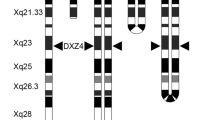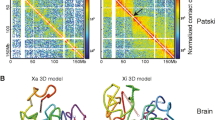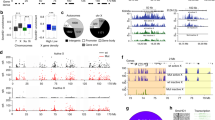Abstract
Euchromatic features are largely absent from the human inactive X chromosome (Xi), with the exception of several large tandem repeats that can be detected as euchromatin bands at metaphase. Despite residing megabases apart, these tandem repeats make frequent inactive X-specific interactions. The mouse homologue has been reported for at least one of the tandem repeats, but whether the mouse Xi is also characterized by distinct bands of euchromatin remains unknown. We examined the mouse Xi for the presence of euchromatin bands by examining the pattern of histone H3 dimethylated at lysine 4 and detected two major signals. The first band resides in the subtelomeric region of band XF5 and may correspond to the pseudoautosomal region. The second band localizes to XE3 and coincides with an extensive complex repeat composed of a large tandem and inverted repeat segment as well as several large short interspersed nuclear element (SINE)-rich tandem repeats. Fluorescence in situ hybridization reveals that sequences with homology to the repeat region are scattered along the length of the Y chromosome. Immunofluorescence analysis of histone H3 trimethylated at lysine 9 on metaphase chromosomes indicates that the repeat region corresponds to a band of constitutive heterochromatin on the male X and female active X chromosomes, whereas the euchromatin signal appears to be female specific. These data suggest that the band of euchromatin observed at XE3 is unique to the mouse Xi, comparable to the chromatin arrangement of several large tandem repeats located on the human X chromosome.









Similar content being viewed by others
Abbreviations
- Astx:
-
Amplified spermatogenic transcripts X encoded
- BAC:
-
Bacterial artificial chromosome
- BSA:
-
Bovine serum albumin
- CTCF:
-
CCCTC-binding factor
- DAPI:
-
4′,6-Diamidino-2-phenylindole
- FISH:
-
Fluorescence in situ hybridization
- H3K4me2:
-
Histone H3 dimethylated at lysine 4
- H3K9me3:
-
Histone H3 trimethylated at lysine 9
- H3K27me3:
-
Histone H3 trimethylated at lysine 27
- kb:
-
Kilobase
- lincRNA:
-
Long noncoding RNA
- LINE:
-
Long interspersed nuclear element
- LTR:
-
Long terminal repeat
- Mb:
-
Megabase
- PAR:
-
Pseudoautosomal region
- PBS:
-
Phosphate-buffered saline
- Rps12:
-
Ribosomal protein S12
- SINE:
-
Short interspersed nuclear element
- Srsx:
-
Serine-rich secreted X-linked
- Vmn2r121:
-
Vomeronasal 2 receptor 121
- Xa:
-
Active X chromosome
- XCI:
-
X chromosome inactivation
- Xi:
-
Inactive X chromosome
- Xic:
-
X inactivation center
- Xist:
-
X inactive-specific transcript
References
Balog J, Miller D, Sanchez-Curtailles E, Carbo-Marques J, Block G, Potman M, de Knijff P, Lemmers RJ, Tapscott SJ, van der Maarel SM (2012) Epigenetic regulation of the X-chromosomal macrosatellite repeat encoding for the cancer/testis gene CT47. Eur J Hum Genet 20(2):185–191. doi:10.1038/ejhg.2011.150
Bernstein BE, Kamal M, Lindblad-Toh K, Bekiranov S, Bailey DK, Huebert DJ, McMahon S, Karlsson EK, Kulbokas EJ, Gingeras TR, Schreiber SL, Lander ES (2005) Genomic maps and comparative analysis of histone modifications in human and mouse. Cell 120(2):169–181
Boggs BA, Cheung P, Heard E, Spector DL, Chinault AC, Allis CD (2002) Differentially methylated forms of histone H3 show unique association patterns with inactive human X chromosomes. Nat Genet 30(1):73–76
Brockdorff N, Ashworth A, Kay GF, McCabe VM, Norris DP, Cooper PJ, Swift S, Rastan S (1992) The product of the mouse Xist gene is a 15kb inactive X-specific transcript containing no conserved ORF and located in the nucleus. Cell 71:515–526
Carrel L, Willard HF (2005) X-inactivation profile reveals extensive variability in X-linked gene expression in females. Nature 434(7031):400–404
Chadwick BP (2007) Variation in Xi chromatin organization and correlation of the H3K27me3 chromatin territories to transcribed sequences by microarray analysis. Chromosoma 116(2):147–157
Chadwick BP (2008) DXZ4 chromatin adopts an opposing conformation to that of the surrounding chromosome and acquires a novel inactive X-specific role involving CTCF and antisense transcripts. Genome Res 18(8):1259–1269
Chadwick BP, Willard HF (2002) Cell cycle-dependent localization of macroH2A in chromatin of the inactive X chromosome. J Cell Biol 157(7):1113–1123
Chadwick BP, Willard HF (2004) Multiple spatially distinct types of facultative heterochromatin on the human inactive X chromosome. Proc Natl Acad Sci U S A 101(50):17450–17455
Clapp J, Mitchell LM, Bolland DJ, Fantes J, Corcoran AE, Scotting PJ, Armour JA, Hewitt JE (2007) Evolutionary conservation of a coding function for D4Z4, the tandem DNA repeat mutated in facioscapulohumeral muscular dystrophy. Am J Hum Genet 81(2):264–279
DeBry RW, Seldin MF (1996) Human/mouse homology relationships. Genomics 33(3):337–351
Giacalone J, Friedes J, Francke U (1992) A novel GC-rich human macrosatellite VNTR in Xq24 is differentially methylated on active and inactive X chromosomes. Nat Genet 1(2):137–143
Horakova AH, Calabrese JM, McLaughlin CR, Tremblay DC, Magnuson T, Chadwick BP (2012a) The mouse DXZ4 homolog retains Ctcf binding and proximity to Pls3 despite substantial organizational differences compared to the primate macrosatellite. Genome Biol 13(8):R70. doi:10.1186/gb-2012-13-8-r70
Horakova AH, Moseley SC, McLaughlin CR, Tremblay DC, Chadwick BP (2012b) The macrosatellite DXZ4 mediates CTCF-dependent long-range intrachromosomal interactions on the human inactive X chromosome. Hum Mol Genet. doi:10.1093/hmg/dds270
Jeppesen P, Turner BM (1993) The inactive X chromosome in female mammals is distinguished by a lack of histone H4 acetylation, a cytogenetic marker for gene expression. Cell 74:281–289
Joung JK, Sander JD (2013) TALENs: a widely applicable technology for targeted genome editing. Nat Rev Mol Cell Biol 14(1):49–55
Lee JT, Bartolomei MS (2013) X-inactivation, imprinting, and long noncoding RNAs in health and disease. Cell 152(6):1308–1323. doi:10.1016/j.cell.2013.02.016
Lyon MF (1961) Gene action in the X-chromosome of the mouse (Mus musculus L.). Nature 190:372–373
Martens JH, O’Sullivan RJ, Braunschweig U, Opravil S, Radolf M, Steinlein P, Jenuwein T (2005) The profile of repeat-associated histone lysine methylation states in the mouse epigenome. EMBO J 24(4):800–812
Mohandas TK, Speed RM, Passage MB, Yen PH, Chandley AC, Shapiro LJ (1992) Role of the pseudoautosomal region in sex-chromosome pairing during male meiosis: meiotic studies in a man with a deletion of distal Xp. Am J Hum Genet 51(3):526–533
Mueller JL, Mahadevaiah SK, Park PJ, Warburton PE, Page DC, Turner JM (2008) The mouse X chromosome is enriched for multicopy testis genes showing postmeiotic expression. Nat Genet 40(6):794–799. doi:10.1038/ng.126
Mueller JL, Skaletsky H, Brown LG, Zaghlul S, Rock S, Graves T, Auger K, Warren WC, Wilson RK, Page DC (2013) Independent specialization of the human and mouse X chromosomes for the male germ line. Nat Genet 45(9):1083–1087. doi:10.1038/ng.2705
Noe L, Kucherov G (2005) YASS: enhancing the sensitivity of DNA similarity search. Nucleic Acids Res 33(Web Server issue):W540–W543. doi:10.1093/nar/gki478
Ohlsson R, Bartkuhn M, Renkawitz R (2010) CTCF shapes chromatin by multiple mechanisms: the impact of 20 years of CTCF research on understanding the workings of chromatin. Chromosoma 119(4):351–360. doi:10.1007/s00412-010-0262-0
Ohno S (1967) Sex chromosomes and sex-linked genes. Springer, Berlin
Page DC, Bieker K, Brown LG, Hinton S, Leppert M, Lalouel JM, Lathrop M, Nystrom-Lahti M, de la Chapelle A, White R (1987) Linkage, physical mapping, and DNA sequence analysis of pseudoautosomal loci on the human X and Y chromosomes. Genomics 1(3):243–256
Pantages E, Dulac C (2000) A novel family of candidate pheromone receptors in mammals. Neuron 28(3):835–845
Pearson PL, Bobrow M (1970) Definitive evidence for the short arm of the Y chromosome associating with the X chromosome during miosis in the human male. Nature 226(5249):959–961
Peng JC, Karpen GH (2008) Epigenetic regulation of heterochromatic DNA stability. Curr Opin Genet Dev 18:204–211
Perry J, Palmer S, Gabriel A, Ashworth A (2001) A short pseudoautosomal region in laboratory mice. Genome Res 11(11):1826–1832. doi:10.1101/gr.203001
Peters AH, Mermoud JE, O’Carroll D, Pagani M, Schweizer D, Brockdorff N, Jenuwein T (2002) Histone H3 lysine 9 methylation is an epigenetic imprint of facultative heterochromatin. Nat Genet 30(1):77–80
Plath K, Fang J, Mlynarczyk-Evans SK, Cao R, Worringer KA, Wang H, de la Cruz CC, Otte AP, Panning B, Zhang Y (2003) Role of histone H3 lysine 27 methylation in X inactivation. Science 300(5616):131–135
Roman AC, Gonzalez-Rio FJ, Molto E, Hernando H, Neto A, Vicente-Garcia C, Ballestar E, Gomez-Skarmeta JL, Vavrova-Anderson J, White RJ, Montoliu L, Fernandez-Salguero PM (2011) Dioxin receptor and SLUG transcription factors regulate the insulator activity of B1 SINE retrotransposons via and RNA polymerase switch. Genome Res 21:422–432
Schaap M, Lemmers RJ, Maassen R, van der Vliet PJ, Hoogerheide LF, van Dijk HK, Basturk N, de Knijff P, van der Maarel SM (2013) Genome-wide analysis of macrosatellite repeat copy number variation in worldwide populations: evidence for differences and commonalities in size distributions and size restrictions. BMC Genomics 14:143. doi:10.1186/1471-2164-14-143
Schmidt D, Schwalie PC, Wilson MD, Ballester B, Goncalves A, Kutter C, Brown GD, Marshall A, Flicek P, Odom DT (2012) Waves of retrotransposon expansion remodel genome organization and CTCF binding in multiple mammalian lineages. Cell 148:335–348
She X, Cheng Z, Zollner S, Church DM, Eichler EE (2008) Mouse segmental duplication and copy number variation. Nat Genet 40(7):909–914. doi:10.1038/ng.172
She X, Jiang Z, Clark RA, Liu G, Cheng Z, Tuzun E, Church DM, Sutton G, Halpern AL, Eichler EE (2004) Shotgun sequence assembly and recent segmental duplications within the human genome. Nature 431(7011):927–930. doi:10.1038/nature03062
Silva J, Mak W, Zvetkova I, Appanah R, Nesterova TB, Webster Z, Peters AH, Jenuwein T, Otte AP, Brockdorff N (2003) Establishment of histone h3 methylation on the inactive x chromosome requires transient recruitment of eed-enx1 polycomb group complexes. Dev Cell 4(4):481–495
Teller K, Illner D, Thamm S, Casas-Delucchi CS, Versteeg R, Indemans M, Cremer T, Cremer M (2011) A top-down analysis of Xa- and Xi-territories reveals differences of higher order structure at >/=20 Mb genomic length scales. Nucleus 2(5):465–477. doi:10.4161/nucl.2.5.17862
Todaro GJ, Green H (1963) Quantitative studies of the growth of mouse embryo cells in culture and their development into established lines. J Cell Biol 17:299–313
Treangen TJ, Salzberg SL (2012) Repetitive DNA and next-generation sequencing: computational challenges and solutions. Nat Rev Genet 13(1):36–46. doi:10.1038/nrg3117
Tremblay DC, Alexander G Jr, Moseley S, Chadwick BP (2010) Expression, tandem repeat copy number variation and stability of four macrosatellite arrays in the human genome. BMC Genomics 11:632. doi:10.1186/1471-2164-11-632
Tremblay DC, Moseley S, Chadwick BP (2011) Variation in array size, monomer composition and expression of the macrosatellite DXZ4. PLoS ONE 6(4):e18969. doi:10.1371/journal.pone.0018969
Warburton PE, Hasson D, Guillem F, Lescale C, Jin X, Abrusan G (2008) Analysis of the largest tandemly repeated DNA families in the human genome. BMC Genomics 9:533
Waterston RH, Lindblad-Toh K, Birney E, Rogers J, Abril JF, Agarwal P, Agarwala R, Ainscough R, Alexandersson M, An P, Antonarakis SE, Attwood J, Baertsch R, Bailey J, Barlow K, Beck S, Berry E, Birren B, Bloom T, Bork P, Botcherby M, Bray N, Brent MR, Brown DG, Brown SD, Bult C, Burton J, Butler J, Campbell RD, Carninci P, Cawley S, Chiaromonte F, Chinwalla AT, Church DM, Clamp M, Clee C, Collins FS, Cook LL, Copley RR, Coulson A, Couronne O, Cuff J, Curwen V, Cutts T, Daly M, David R, Davies J, Delehaunty KD, Deri J, Dermitzakis ET, Dewey C, Dickens NJ, Diekhans M, Dodge S, Dubchak I, Dunn DM, Eddy SR, Elnitski L, Emes RD, Eswara P, Eyras E, Felsenfeld A, Fewell GA, Flicek P, Foley K, Frankel WN, Fulton LA, Fulton RS, Furey TS, Gage D, Gibbs RA, Glusman G, Gnerre S, Goldman N, Goodstadt L, Grafham D, Graves TA, Green ED, Gregory S, Guigo R, Guyer M, Hardison RC, Haussler D, Hayashizaki Y, Hillier LW, Hinrichs A, Hlavina W, Holzer T, Hsu F, Hua A, Hubbard T, Hunt A, Jackson I, Jaffe DB, Johnson LS, Jones M, Jones TA, Joy A, Kamal M, Karlsson EK, Karolchik D, Kasprzyk A, Kawai J, Keibler E, Kells C, Kent WJ, Kirby A, Kolbe DL, Korf I, Kucherlapati RS, Kulbokas EJ, Kulp D, Landers T, Leger JP, Leonard S, Letunic I, Levine R, Li J, Li M, Lloyd C, Lucas S, Ma B, Maglott DR, Mardis ER, Matthews L, Mauceli E, Mayer JH, McCarthy M, McCombie WR, McLaren S, McLay K, McPherson JD, Meldrim J, Meredith B, Mesirov JP, Miller W, Miner TL, Mongin E, Montgomery KT, Morgan M, Mott R, Mullikin JC, Muzny DM, Nash WE, Nelson JO, Nhan MN, Nicol R, Ning Z, Nusbaum C, O’Connor MJ, Okazaki Y, Oliver K, Overton-Larty E, Pachter L, Parra G, Pepin KH, Peterson J, Pevzner P, Plumb R, Pohl CS, Poliakov A, Ponce TC, Ponting CP, Potter S, Quail M, Reymond A, Roe BA, Roskin KM, Rubin EM, Rust AG, Santos R, Sapojnikov V, Schultz B, Schultz J, Schwartz MS, Schwartz S, Scott C, Seaman S, Searle S, Sharpe T, Sheridan A, Shownkeen R, Sims S, Singer JB, Slater G, Smit A, Smith DR, Spencer B, Stabenau A, Stange-Thomann N, Sugnet C, Suyama M, Tesler G, Thompson J, Torrents D, Trevaskis E, Tromp J, Ucla C, Ureta-Vidal A, Vinson JP, Von Niederhausern AC, Wade CM, Wall M, Weber RJ, Weiss RB, Wendl MC, West AP, Wetterstrand K, Wheeler R, Whelan S, Wierzbowski J, Willey D, Williams S, Wilson RK, Winter E, Worley KC, Wyman D, Yang S, Yang SP, Zdobnov EM, Zody MC, Lander ES (2002) Initial sequencing and comparative analysis of the mouse genome. Nature 420(6915):520–562. doi:10.1038/nature01262
Wutz A (2011) Gene silencing in X-chromosome inactivation: advances in understanding facultative heterochromatin formation. Nat Rev Genet 12(8):542–553. doi:10.1038/nrg3035
Zeng W, de Greef JC, Chen YY, Chien R, Kong X, Gregson HC, Winokur ST, Pyle A, Robertson KD, Schmiesing JA, Kimonis VE, Balog J, Frants RR, Ball AR Jr, Lock LF, Donovan PJ, van der Maarel SM, Yokomori K (2009) Specific loss of histone H3 lysine 9 trimethylation and HP1gamma/cohesin binding at D4Z4 repeats is associated with facioscapulohumeral dystrophy (FSHD). PLoS Genet 5(7):e1000559. doi:10.1371/journal.pgen.1000559
Acknowledgements
This work was supported by the National Institutes of Health [GM073120 to B.P.C.].
Ethical standards
Experiments performed in this manuscript comply with the current laws of the USA.
Conflict of interest
The authors declare they have no conflict of interest.
This article does not contain any studies with human or animal subjects performed by any of the authors.
Author information
Authors and Affiliations
Corresponding author
Additional information
Responsible Editor: Beth A. Sullivan
Rights and permissions
About this article
Cite this article
Darrow, E.M., Seberg, A.P., Das, S. et al. A region of euchromatin coincides with an extensive tandem repeat on the mouse (Mus musculus) inactive X chromosome. Chromosome Res 22, 335–350 (2014). https://doi.org/10.1007/s10577-014-9424-x
Received:
Revised:
Accepted:
Published:
Issue Date:
DOI: https://doi.org/10.1007/s10577-014-9424-x




